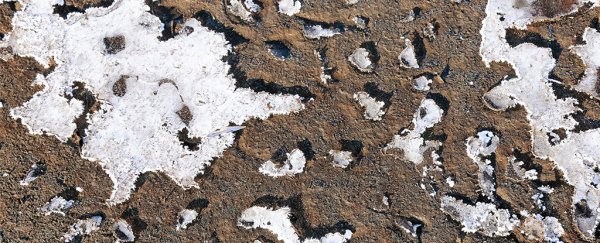Permafrost in Canada, Alaska and Siberia is abruptly crumbling in ways that could release large stores of greenhouse gases more quickly than anticipated, researchers have warned.
Scientists have long fretted that climate change - which has heated Arctic and subarctic regions at double the global rate - will release planet-warming CO2 and methane that has remained safely locked inside Earth's frozen landscapes for millennia.
It was assumed this process would be gradual, leaving humanity time to draw down carbon emissions enough to prevent permafrost thaw from tipping into a self-perpetuating vicious circle of ice melt and global warming.
But a study published on Monday in Nature Geoscience says projections of how much carbon would be released by this kind of slow-and-steady thawing overlook a less well-known process whereby certain types of icy terrain disintegrate suddenly - sometimes within days.
"Although abrupt permafrost thawing will occur in less than 20 percent of frozen land, it increases permafrost carbon release projections by about 50 percent," said lead author Merritt Turetsky, head of the Institute of Arctic and Alpine Research in Boulder, Colorado.
"Under all future warming scenarios, abrupt thaw leads to net carbon losses into the atmosphere," she told AFP.
Permafrost contains rocks, soil, sand and pockets of pure ground ice. Its rich carbon content is the remains of life that once flourished in the Arctic, including plants, animals and microbes.
This matter - which never fully decomposed - has been frozen for thousands of years.
It stretches across an area nearly as big as Canada and the United States combined, and holds about 1,500 billion tonnes or carbon - twice as much as in the atmosphere and three times the amount humanity has emitted since the start of industrialisation.
Some of this once rock-solid ground has begun to soften, upending indigenous communities and threatening industrial infrastructure across the sub-Arctic region, especially in Russia.
The evidence is mixed as to whether this not-so-permanent permafrost has started to vent significant quantities of methane or CO2.
Projections are also uncertain, with some scientists saying future emissions may be at least partially offset by new vegetation, which absorbs and stores CO2.
But there is no doubt, experts say, that permafrost will continue to give way as temperatures climb.
'Fast and dramatic'
In a special report published in September, the UN's scientific advisory body for climate change, the IPCC, looked at two scenarios.
If humanity manages - against all odds - to cap global warming at under 2°C, the cornerstone goal of the 2015 Paris climate treaty, "permafrost area shows a decrease of 24 percent by 2100", it concluded.
At the other extreme, if fossil fuel emissions continue to grow over the next 50 years - arguably an equally unlikely prospect - up to 70 percent of permafrost could disappear, the IPPC said.
But both scenarios assume the loss will be gradual, and that may be a mistake, Turetsky suggested.
"We estimate that abrupt permafrost thawing - in lowland lakes and wetlands, together with that in upland hills - could release 60 to 100 billion tonnes of carbon by 2300," she and colleagues noted in a 2019 comment also published by Nature.
One tonne of carbon is equivalent to 3.67 tonnes of carbon dioxide (CO2), which means this would be equivalent to about eight years of global emissions at current rates.
"This is in addition to the 200 billion tonnes of carbon expected to be released in other regions that will thaw gradually," she said.
Current climate models do not account for the possibility of rapid permafrost collapse and the amount of gases it might release, the study notes.
Abrupt thawing is "fast and dramatic", Merritt said, adding: "Forests can become lakes in the course of a month, landslides can occur with no warning, and invisible methane seep holes can swallow snowmobiles whole."
